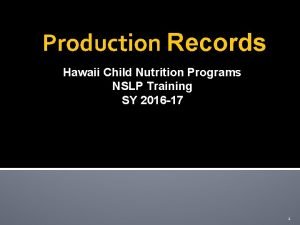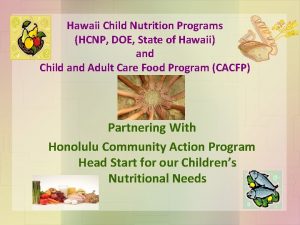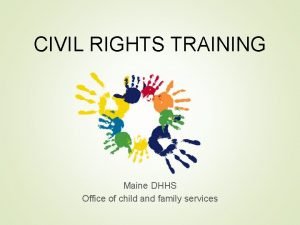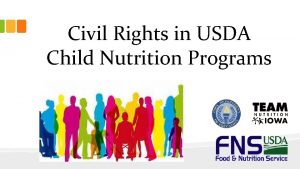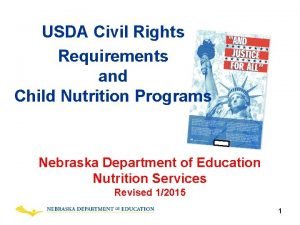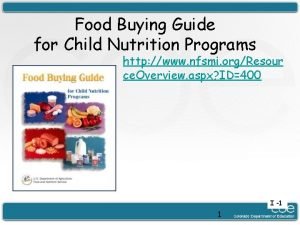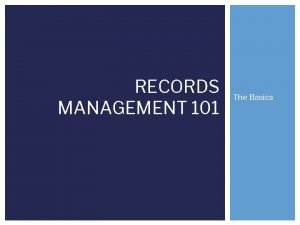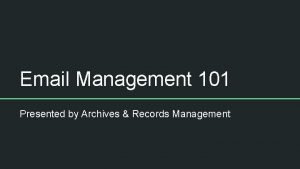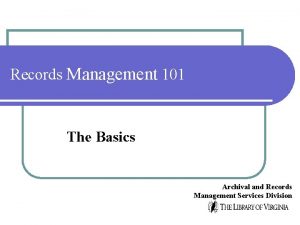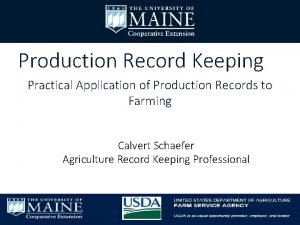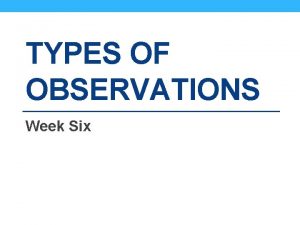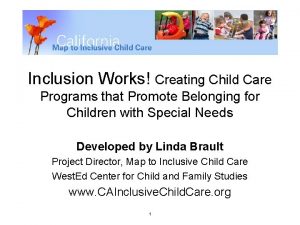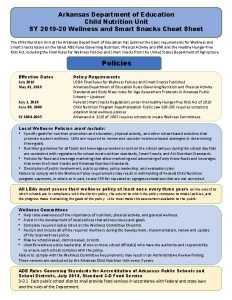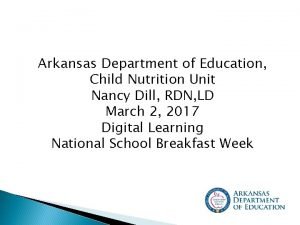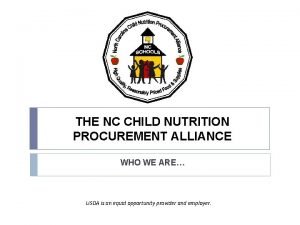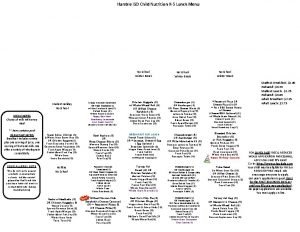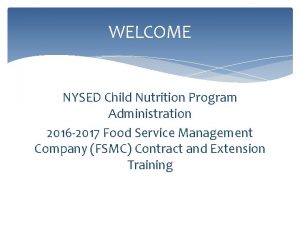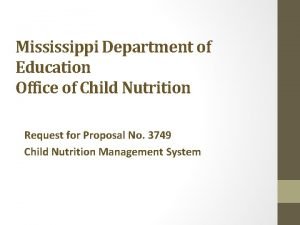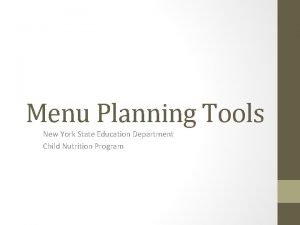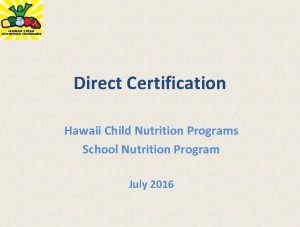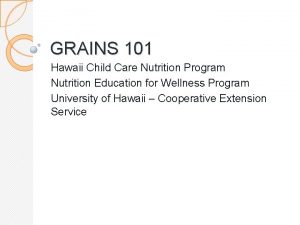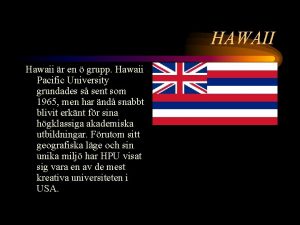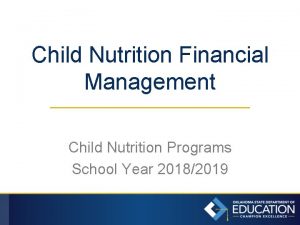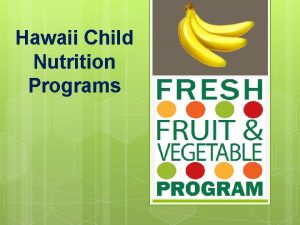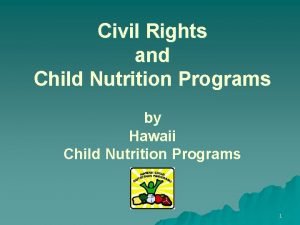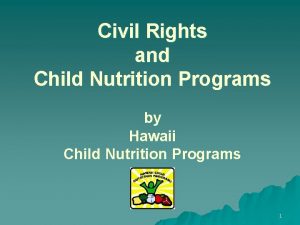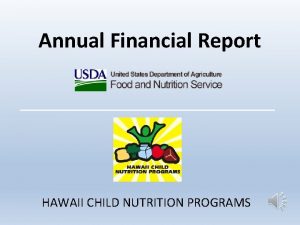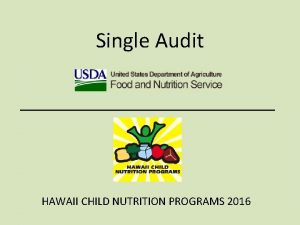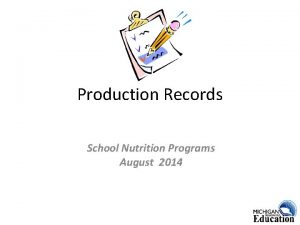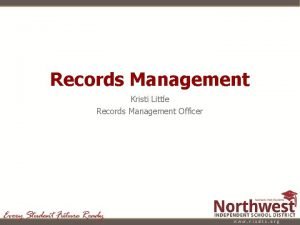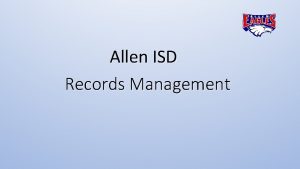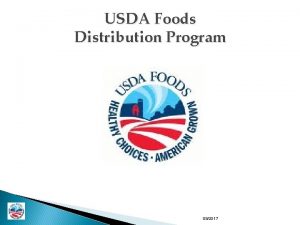Production Records 101 Hawaii Child Nutrition Programs NSLP























- Slides: 23

Production Records 101 Hawaii Child Nutrition Programs NSLP Training SY 2017 -18

Why Production Records? A required daily document that records all reimbursable meals prepared and served daily through the National School Lunch Program and School Breakfast Program.


Production Records EVERY ONE WORKS ON PRODUCTION RECORDS THE MANAGER IS RESPONSIBLE FOR ENSURING THEY ARE CORRECT Kitchen Manager Kitchen Staff

Production Records - WHY Supports meal claims submitted for reimbursement To help manage the food service operation To demonstrate compliance with the meal pattern requirements for each age/grade group Records are reviewed during an AR (years) and SFSB Supervisor (annually by Feb) Records must be kept for 3 (6 DOE) years plus the current school year

Production Records- WHEN Information is recorded at 3 different times: Prior to production 2. During meal production 3. Immediately after the meal service 1. PRs contain historical and future information about the mealsplanned, prepared, and served. 1. (PS Please don’t do the scrap paper routine!)

Production Records No Production Records = Fiscal Action!!

Production Records PLEASE DO THEM DAILY If you get behind, its hard to catch up.

Production Records- WHAT Production Records are a communication tool for your kitchen. Essential information is communicated between the manager, line servers and production staff? NOT USING THE PRODUCTION RECORDS MAKES YOUR JOB MUCH HARDER

3 Functions of a Production Record 1. Production Records are a communication tool. Essential information is communicated between the kitchen staff, manager and production staff? Use it as a management tool to: • • • Evaluate acceptability of meals – send info to menu committee. Forecasting and finding recipe numbers Ordering your staple and frozen foods Work schedules for employees Reminders for needed paper goods, produce, etc.

3 Functions of a Production Record #2. Production Record: • Identify customer acceptance to forecast how to much to make that day. • Reduces waste from overproduction; saves employee frustration • Place to make corrections to recipes, yields, improvements, employee assignments, etc. • One place for all kitchen notes!

3 Functions of a Production Record #3. Production Records: • Prevents under production • Tells serving staff size scoops, bundling information, what to sub if running out, other facts such as past field trips, weather, school-wide illnesses…

3 Day Average for Forecasting Sometimes the last time a menu item was served, there were variables that effected its true acceptance. Use a 3 day average to make more accurate. EASY-PEASY: add last three times served then divide by 3.

EASY-PEASY: add last three times served then divide by 3. Use this number to make the number of serving for day. Menu item Pizza Avg. 1/16 2/27 4/3 155 162 170 Number of Planned Portions 5/15 162. 3 163 14

Forecasting Food Buying Guide • Determines how much food to purchase and prepare by edible portion. • Identifies each food item’s contribution to the meal pattern https: //www. fns. usda. gov/tn/food-buying-guide-for-childnutrition-programs Food Buying Guide Calculators for each of the 6 food groups in the Food Buying Guide. Now an phone app too!

What to complete before the Meal Service

What to complete at end of meal Record food temperatures in ink, not pencil.

What to complete at end of day

LEFTOVERS • Documenting your leftovers is very important forecasting. • Keep all food that have been “under temperature”. • Document the number of portions you have left after all students have been served, but before the food is thrown away. • In the comments section or to the right of the leftover column, document what was done with the leftovers. • Freezer (F), Cooler (C), Waste (W) DATE ALL FOODS BEFORE STORING

SUBSTITUTIONS/ADD-ONS All substitutions or add-ons must be recorded on the production record. Mark one line through the original menu item and write in the substitution. Complete PR on the new item



CIVIL RIGHTS In accordance with Federal civil rights law and U. S. Department of Agriculture (USDA) civil rights regulations and policies, the USDA, its Agencies, offices, and employees, and institutions participating in or administering USDA programs are prohibited from discriminating based on race, color, national origin, sex, disability, age, or reprisal or retaliation for prior civil rights activity in any program or activity conducted or funded by USDA. Persons with disabilities who require alternative means of communication for program information (e. g. Braille, large print, audiotape, American Sign Language, etc. ), should contact the Agency (State or local) where they applied for benefits. Individuals who are deaf, hard of hearing or have speech disabilities may contact USDA through the Federal Relay Service at (800) 877 -8339. Additionally, program information may be made available in languages other than English. To file a program complaint of discrimination, complete the USDA Program Discrimination Complaint Form, (AD 3027) online and at any USDA office, or write a letter addressed to USDA and provide in the letter all of the information requested in the form. To request a copy of the complaint form, call (866) 632 -9992. Submit your completed form or letter to USDA by: 1. mail: U. S. Department of Agriculture Office of the Assistant Secretary for Civil Rights 1400 Independence Avenue, SW Washington, D. C. 20250 -9410; 2. fax: (202) 690 -7442; or 3. email: program. intake@usda. gov This institution is an equal opportunity provider.
 Nslp production record template
Nslp production record template Hcnp
Hcnp Civil rights training child nutrition programs
Civil rights training child nutrition programs Civil rights in child nutrition programs
Civil rights in child nutrition programs Civil rights in child nutrition programs
Civil rights in child nutrition programs Food buying guide
Food buying guide Jelaskan 3 proses alur produksi multimedia
Jelaskan 3 proses alur produksi multimedia Collection of programs written to service other programs.
Collection of programs written to service other programs. Records management 101
Records management 101 Email
Email Records management 101
Records management 101 What is a production record
What is a production record Time sampling
Time sampling National programs
National programs National network of child psychiatry access programs
National network of child psychiatry access programs Inclusion works creating child care programs
Inclusion works creating child care programs National network of child psychiatry access programs
National network of child psychiatry access programs Arkansas child nutrition unit
Arkansas child nutrition unit Child nutrition unit arkansas
Child nutrition unit arkansas Ncdpi child nutrition
Ncdpi child nutrition Conroe isd lunch menu
Conroe isd lunch menu Nysed child nutrition
Nysed child nutrition Office of child nutrition
Office of child nutrition Product formulation statement
Product formulation statement
